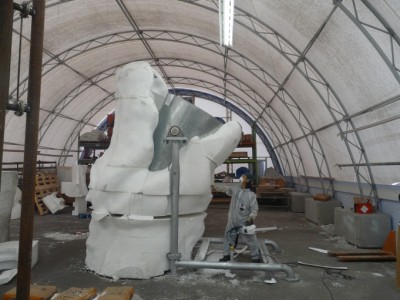Sculpting an alligator

In order to finish constructing the alligator in Kelowna, a mock-up section of the water play centre was fabricated using part of another fibreglass slide so the slide could be incorporated into the alligator’s tail.
The unit was then assembled as complete as possible, minus the head, to start the sculpting process. This was a painstaking task, as the reality and proportion of the alligator relied heavily on the skill of the sculptors. Although it sounds relatively simple, in this case, sculpting the alligator was quite difficult, as only a small percentage of the structure was visible at a time. This meant sculptors had to frequently step back from the project to assess progress and perspective.
To incorporate the tipping bucket into the mouth of the alligator, its head had to be formed around the bucket. In order to allow the tipping bucket to fall, the alligator’s jaw was fixed to the bucket. This would allow the lower jaw to open as the bucket tips and discharges 1,200 L (317 gal.) of water onto a lower splash roof.
After consensus was reached that the alligator was realistic and proportional, construction joints were placed at strategic positions in the structure to allow disassembly into shippable sub-assemblies.
The next step was hard coating the entire structure (i.e. body and head). This is a form of waterproofing, which prevents water from penetrating into the Styrofoam and rendering it unusable. Once this was completed, the alligator was painted. First, a base coat was applied to provide the background colour (creamy grey) of the albino alligator, and then intricate details were added to produce the alligator’s scaly appearance. Final painting and hard coating of the construction joints was performed on-site after the structure was assembled.
Shipping and assembly
The completed alligator was shipped in sections on flatbed trucks. Unfortunately, however, the body section was too big to be transported in this manner. As a result, it had to be shipped on a specialized ‘over-width’ transport truck, which had to travel with pilot cars through Louisiana.

Once all the components arrived to the Audubon Zoo, construction of the alligator was performed by Francise Articultural Services of New Orleans under the direction of WhiteWater’s supervisors who also assisted with assembly. This involved filling any voids between the parts with expanding foam, overlaying the joints with fibreglass matting, gel coating and painting to match the rest of the alligator.
When construction was complete, the alligator-themed water play centre measured 8.5-m (28-ft) tall and 10-m (33-ft) long. In addition to the standard features, the water play centre was also equipped with 60 additional elements, including interactive tipping cones, jets, spray nozzles, valves, water guns, as well as waterslides, pull ropes and a climbing net. To increase the alligator’s realism, programmable, timed sound effects were also added to the water play centre to further entertain Audubon Zoo’s guests.
 Colin Atkinson is a senior project manager with WhiteWater West Industries, a waterpark and aquatic attraction design/build firm in Richmond, B.C. He has been with the company for more than four years and has managed several key projects, including installations at the recently expanded North Richland Hills Family Waterpark (NRH2O) in North Richland Hills, Texas and Wayne Gray Waterpark in Baytown, Texas. He can be reached via e-mail at colin.atkinson@whitewaterwest.com.
Colin Atkinson is a senior project manager with WhiteWater West Industries, a waterpark and aquatic attraction design/build firm in Richmond, B.C. He has been with the company for more than four years and has managed several key projects, including installations at the recently expanded North Richland Hills Family Waterpark (NRH2O) in North Richland Hills, Texas and Wayne Gray Waterpark in Baytown, Texas. He can be reached via e-mail at colin.atkinson@whitewaterwest.com.






